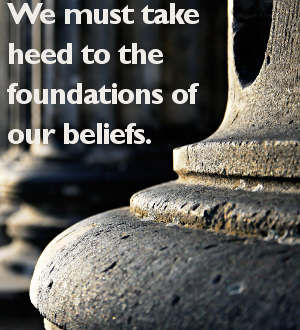The Meaning of "Fundamentalism"
 Fundamentalism as Defined by Fundamentalists
Fundamentalism as Defined by Fundamentalists
In 1920 Curtis Lee Laws, editor of the Northern Baptist paper The Watchman-Examiner, coined the word “Fundamentalists” to describe those “who still cling to the great fundamentals and who mean to do battle royal” against theological liberalism. Laws’ definition of Fundamentalism was essentially theological, concerned with preserving orthodox doctrine. Yet within sixty years Fundamentalism had become a word to describe religious extremism of every kind. Fundamentalism is no longer a label for only orthodox American Protestants; today, Islamic terrorists, Ultra-Orthodox Jews, and Hindu extremists are all considered Fundamentalists by the popular media, academics, and even many religious historians. “Fundamentalism” has become a catch-all term for any religious “dangerous other.”
Fundamentalism as Defined by Modernists
Unsurprisingly, theological modernists in the 1920s and 30s contested the meaning of Fundamentalism. Rather than seeing Fundamentalists as heroic preservers of sound doctrine, modernists accused Fundamentalists of being narrow-minded, backward pedants who obstinately refused to update Christianity to reflect modern times. In his famous 1922 sermon “Shall the Fundamentalists Win?” Harry Emerson Fosdick, modernist pastor of New York’s First Presbyterian Church, argued that “we must be able to think our modern life clear through in Christian terms, and to do that we also must be able to think our Christian faith clear through in modern terms.” Modernists believed that Fundamentalism was a movement at the cultural margins of early twentieth century America. Thus Fosdick had noted that the strength of Fundamentalism lay in the “Middle West.” The 1925 Scopes Trial, and the coverage of the trial by influential Northeastern reporters like H. L. Mencken, encouraged this perception of Fundamentalism. So despite the fact that Fundamentalism was actually a predominately middle class, urban movement, H. Richard Niebuhr’s 1937 entry on “Fundamentalism” in the Encyclopaedia of the Social Sciences (vol 5, New York City: MacMillan) declared that “in the social sources from which it drew its strength Fundamentalism was closely related to the conflict between rural and urban cultures in America.” Niebuhr believed that it was modernism that found “its strength in the cities and in the churches supported by the urban middle classes.”
Discussion
Fundamentalism: Whence? Where? Whither? Part 4

Fundamentalism and Populism
Read Part 1, Part 2, and Part 3.
Prior to Thomas Reid and Scottish Common Sense Realism, people typically recognized a distinction between appearances (whether understood as perceptions, phenomena, or, in Locke’s case, ideas) and reality. From antiquity until the late Middle Ages, this distinction had produced two effects upon the way that most people thought about reality. First, they reckoned that whatever reality they encountered had to be interpreted—and not everyone was in an equally good position to do the interpreting. Second, they believed that reality possessed dimensions of meaning or significance that stretched well beyond sensory awareness. Grasping those levels of meaning was also something that not everyone was equally qualified to do.
Common Sense Realists denied the distinction between appearance and reality. They insisted that perceiving subjects have direct and unmediated access to reality itself. Consequently, reality does not need to be interpreted—it is as it appears to be. This move had the effect of placing every person on an equal footing for understanding any aspect of reality.
As presented by people like Reid and Dugald Stewart, Common Sense Realism was a responsible if misguided academic option. Ironically, however, many of the people who appropriated and applied Reid’s conclusions would not have been capable of understanding his arguments. Chief among them were Americans.
Even before Reid, Americans had begun to affirm the competence of the ordinary person in all matters. This perspective is called populism. The harshness of the American frontier and the necessity of individual accomplishment tended to negate aristocratic influences. The sense that they were starting anew gave Americans an antipathy toward traditions. The arrival of Common Sense Realism confirmed the populist prejudice and opened the throttle for its acceleration. This process continued throughout the Jeffersonian and Jacksonian periods.
Discussion
Fundamentalism: Whence? Where? Whither? Part 3

Fundamentalism Common Sense
By definition, Fundamentalism does not concern itself with the whole counsel of God. As the name implies, it concerns itself with fundamentals, i.e., with those matters that are essential to the bare existence of Christianity. Fundamentalists may, and many Fundamentalists actually do, go beyond this limited concern. When they do so, however, they are no longer acting merely as Fundamentalists, but as Fundamentalists who also happen to be something else.
On one hand, as an actual, historical movement, Fundamentalism has often tended to settle for an abbreviated form of Christianity. Though clear exceptions exist, it has often sacrificed doctrinal breadth and detail. On the other hand, Fundamentalism has also tended to add elements that are not necessary to any form of biblical Christianity. Over the next few essays, I wish to explore three of these additions: Common Sense Realism, populism, and sentimentalism.
Common Sense Realism was a reaction to and development of Enlightenment philosophy. It was articulated by Thomas Reid of Aberdeen (later Glasgow) and sold to the philosophical world by Dugald Stewart of Edinburgh. A relatively late development, Common Sense Realism represented an attempt to circumvent several philosophical impasses. Continental rationalism had never been able to move convincingly beyond solipsism. British empiricism had led to the subjective idealism of Berkeley and the skepticism of Hume.
Reid hoped to get past these problems by grounding knowledge in a core of self-evident common sense. Where earlier thinkers had distinguished appearance from reality, Reid posited that people perceive reality directly. Normally, perceptions can be relied upon as accurate and trustworthy. For Common Sense Realism, reality is transparently available to the perceiving subject.
Discussion
Confidence in the Word, Part 2
 The church at Colosse apparently had come under the influence of the early stages of Gnosticism. Gnostics taught that certain individuals were privy to mystical sources of knowledge beyond the Scriptures. If one wanted to move on to maturity, according to the Gnostics, he had to tap into this extra-biblical knowledge through the methods that they taught. The Colossians, under this influence, were leaving behind the apostolic instruction concerning the Christian life (vv. 1-7) and were being deluded into adding at least five things to God’s Word.
The church at Colosse apparently had come under the influence of the early stages of Gnosticism. Gnostics taught that certain individuals were privy to mystical sources of knowledge beyond the Scriptures. If one wanted to move on to maturity, according to the Gnostics, he had to tap into this extra-biblical knowledge through the methods that they taught. The Colossians, under this influence, were leaving behind the apostolic instruction concerning the Christian life (vv. 1-7) and were being deluded into adding at least five things to God’s Word.
Philosophy
Colossians 2:8-15 warns of the danger of being taken captive through philosophy and empty deception. “Philosophy” means the “love of wisdom” and the book of Proverbs tells us that the love of wisdom is a worthy pursuit (Proverbs 4:6). God does not oppose wisdom; He is against the wrong kind of wisdom. Paul warns of a pseudo-wisdom that can be identified by three characteristics:
• It is according to the traditions of men. That is, wisdom that comes from the mind of men, not the mind of God.
• It is according to the elementary principles of the world. This is likely a reference to the attempt to gain esoteric knowledge through mystical means, something the Gnostics loved (see v. 18).
• It is not according to Christ. True wisdom is found in Christ “in whom are hidden all the treasures of wisdom and knowledge” (v. 3). The Colossians were searching in the wrong place for wisdom. What they were looking for was found in Christ, through the Word, not in the philosophies of men.
Discussion
Confidence in the Word, Part 1

Discussion
Fundamentalism: Whence? Where? Whither? Part 1

Things Have Changed
The last sustained history of fundamentalism to be published by a fundamentalist was David Beale’s In Pursuit of Purity1. Nearly a generation has passed since Beale finished writing his book. During that time the landscape of fundamentalism has altered significantly.
The period when Beale was writing was a time of intense struggle within fundamentalism. Segments of the movement were denouncing other segments as “neo” this or “pseudo” that. One wing of fundamentalism (led by Jerry Falwell, Ed Dobson, Ed Hindson, and Jack Van Impe) was attempting to forge links with mainstream evangelicalism. From the opposite wing, Bob Jones Jr. was attacking John MacArthur’s views on the blood of Christ and declaring that “MacArthur’s position is heresy.”2 The King James Only movement, pioneered by David Otis Fuller and D. A. Waite, was in its infancy, barely a cloud the size of a man’s hand.
Many of the events that define present-day fundamentalism were yet future. Robert Sumner had not yet published his exposé of Jack Hyles’s (alleged) affair, and Hyles himself was regarded as a prominent leader within mainstream fundamentalism. Cornerstone College was still Grand Rapids Baptist College, an approved agency of the General Association of Regular Baptist Churches, and the GARBC was still approving agencies. Bob Jones University, smarting from its recent rebuff by the United States Supreme Court, continued to defend its ban on interracial dating and marriage as “based on its understanding of the Bible.”3 Perhaps most significantly, the conservative resurgence within the Southern Baptist Convention was still in its infancy. Conservatives controlled no Southern Baptist institutions yet, and most fundamentalists doubted that they ever would.
In 1986, neither Dave Doran nor Tim Jordan held the pastorates that have come to be associated with their names. Dan Davey and Mark Minnick were associate pastors in Virginia Beach and Greenville, respectively. Matt Olson was just a few years into the planting of Tri-City Baptist Church near Denver. John Hartog III was a college student, and Stephen Jones was still in high school.
Discussion
The Foundations of the Fundamentals

Most fundamentalists are familiar with the “Five Fundamentals of the Faith” upon which early twentieth-century Fundamentalism was founded. The inspiration of Scripture, the virgin birth, the deity of Christ, His substitutionary atonement, and His resurrection and physical return to earth are the absolute basics of an orthodox framework of Christian faith. What the last thirty years has revealed, however, is that these five fundamentals are not enough to safeguard orthodoxy by themselves, and are no longer sufficient as a test for orthodoxy.
A case in point is the issue of inspiration. Some of the most lethal attacks against the Scriptures in recent years have affirmed inspiration (and even inerrancy). At the same time, they have rejected the veracity and authority of Scripture (for example, see the recent book [amazon 0801027012] by Kenton Sparks; Baker, 2008).
The reason the historic five fundamentals are no longer a sufficient test for orthodoxy is the fact that they rest on a more basic metaphysical foundation that has been quietly undermined by philosophy. (In this essay, the term “foundation” has nothing to do with foundationalist epistemology.) Philosophers, and theologians who have been heavily influenced by philosophy, have ceded key aspects of the doctrine of God that seem to conflict with philosophy’s demands. Rather than keeping philosophy in its proper place as the handmaid of theology, some have allowed the servant to become master. In doing so, the foundation of our theology has been subtly undermined. If we do not take heed to the foundations of our beliefs, we will not know that the framework has been undermined until it is too late. We will be like front line soldiers resisting the visible enemy encamped across the field, while a stronger force tunnels underneath our lines preparing to attack from the rear.

Discussion